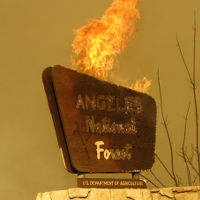"Many Southern California recreationists don’t understand the floodwaters that created the rock- and boulder-strewn, 100- to 200-foot wide channels they’re walking in or along -- especially when there’s no more than one- to two-foot wide ribbons of water running through them normally, Taylor said.
“These aren’t rocks that rolled off the side of a mountain. They’re pushed there by water and mud,” he said. “You’re in an environment that’s not showing you the power it took to create that environment.”
http://www.pe.com/articles/water-782371 ... flood.html
Good article on flash floods
-
SGBob

- Posts: 101
- Joined: Wed Jan 07, 2015 12:47 pm
I was working in San Gabriel Canyon the day that the flash floods struck Mt. Baldy - August 3, 2014. The flash flood was roaring down the East Fork. We were told to take a run to Heaton Flat and see if we could see anyone stranded on the other side of the river, or in the middle and if we found anything to radio Air 5 as they flew down the canyon looking for the same. As we were driving across the Cattle Canyon bridge two women flagged us down. They looked very alarmed and we thought we were about to do a swift water rescue. When we stopped and I rolled down the window the woman shouted angrily at me, "How come there aren't any signs warning us that this can happen!?!?!?"
I spent the next few minutes thinking of various ways to word such a sign. I settled on, "when it rains really hard it might end up in the river."
I spent the next few minutes thinking of various ways to word such a sign. I settled on, "when it rains really hard it might end up in the river."
